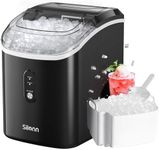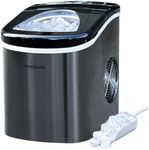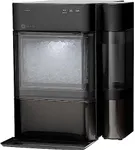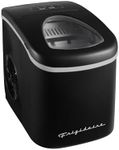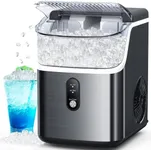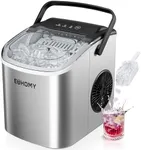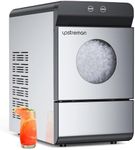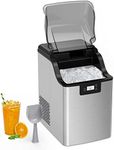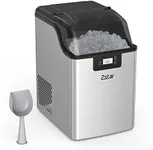Buying Guide for the Best Small Ice Makers
When choosing a small ice maker, it's important to consider your specific needs and preferences. Small ice makers are great for home use, small gatherings, or even for use in an RV or boat. They are compact, portable, and can produce ice quickly. To make the best choice, you should understand the key specifications and how they align with your requirements. Here are some important specs to consider when selecting a small ice maker.Ice Production CapacityIce production capacity refers to the amount of ice the machine can produce in a 24-hour period. This is important because it determines how much ice you can have on hand. If you frequently host parties or have a large family, you might need a higher capacity, typically around 26-35 pounds per day. For occasional use or smaller households, a lower capacity of 20-25 pounds per day might be sufficient. Consider your typical ice usage to determine the right capacity for you.
Ice Storage CapacityIce storage capacity is the amount of ice the machine can hold at one time. This is crucial because it affects how often you need to empty the ice bin. If you need a constant supply of ice, look for a machine with a larger storage capacity, usually around 2-3 pounds. For less frequent use, a smaller storage capacity of 1-2 pounds may be adequate. Think about how often you will use the ice and how much you need at any given time to choose the right storage capacity.
Ice Size and ShapeDifferent ice makers produce different sizes and shapes of ice, such as bullet, nugget, or cube. This is important because the type of ice can affect how quickly it melts and how it fits in your drinks. Bullet ice is common in small ice makers and melts slower, making it ideal for beverages. Nugget ice is softer and chewier, preferred for cocktails and soft drinks. Cube ice is versatile and melts slower. Consider your preference and the primary use of the ice when selecting the size and shape.
Cycle TimeCycle time refers to how long it takes for the ice maker to produce a batch of ice. This is important if you need ice quickly. Most small ice makers have a cycle time of 6-15 minutes. If you need ice on demand, look for a machine with a shorter cycle time. For less urgent needs, a longer cycle time may be acceptable. Think about how quickly you need ice and how often you will be using the machine to determine the appropriate cycle time.
PortabilityPortability is a key feature for small ice makers, especially if you plan to move it around or take it with you on trips. This includes the weight and size of the machine. Lighter and more compact models are easier to transport and store. If you need an ice maker for camping, boating, or RV use, prioritize portability. For home use, portability might be less critical, but a compact size can still be beneficial for saving counter space.
Ease of UseEase of use encompasses features like user-friendly controls, clear indicators, and easy maintenance. This is important because it affects your overall experience with the ice maker. Look for models with simple controls, such as one-touch buttons, and indicators that show when the ice bin is full or when water needs to be added. Easy maintenance features, like self-cleaning functions, can save you time and effort. Consider how much convenience you want in operating and maintaining the ice maker.
Noise LevelNoise level refers to how loud the ice maker is during operation. This is important if you plan to use the ice maker in a quiet environment, like a home office or bedroom. Some ice makers can be quite noisy, while others operate more quietly. If noise is a concern, look for models that are specifically designed to be quieter. Think about where you will be using the ice maker and how much noise you can tolerate to choose the right model.

